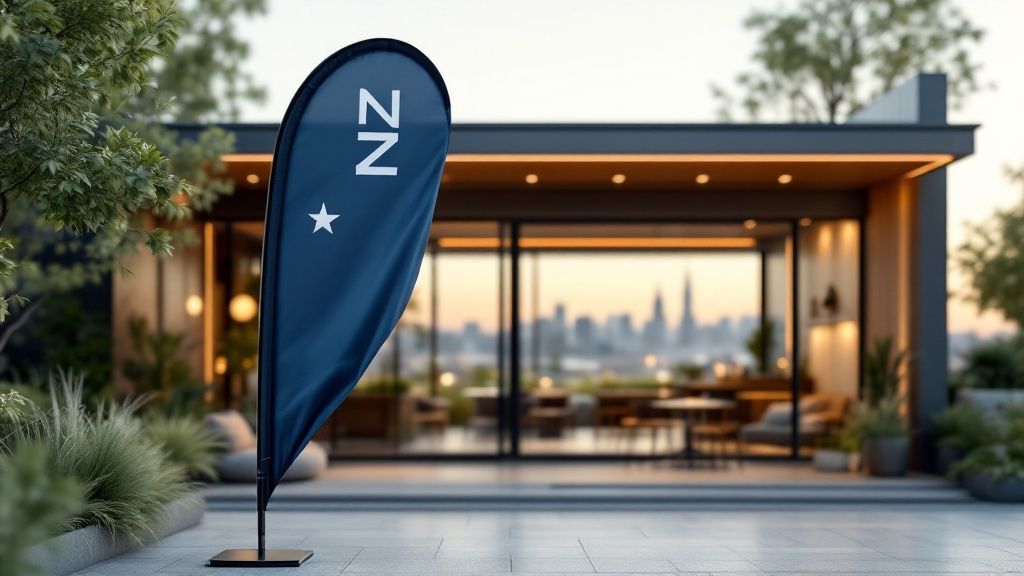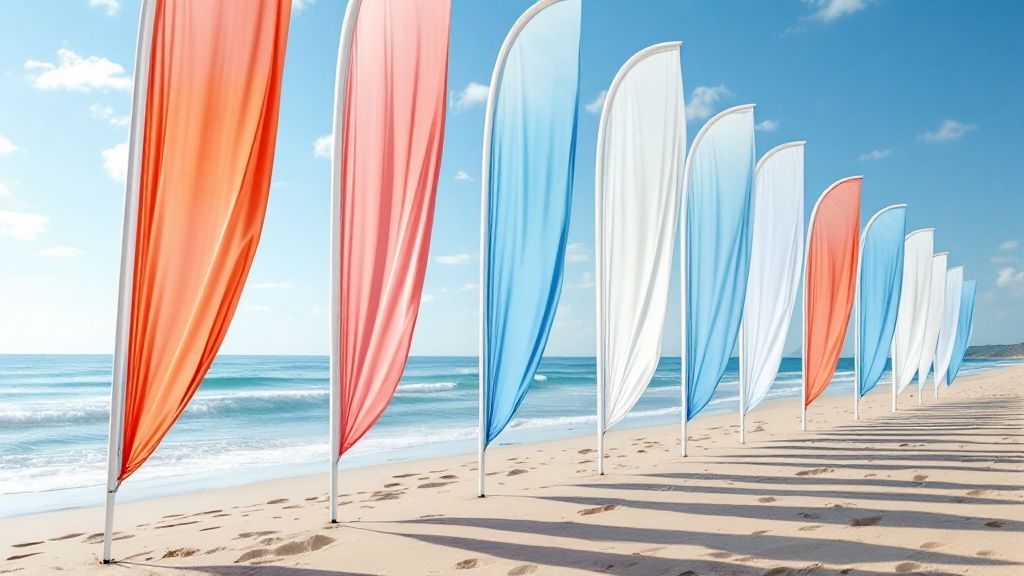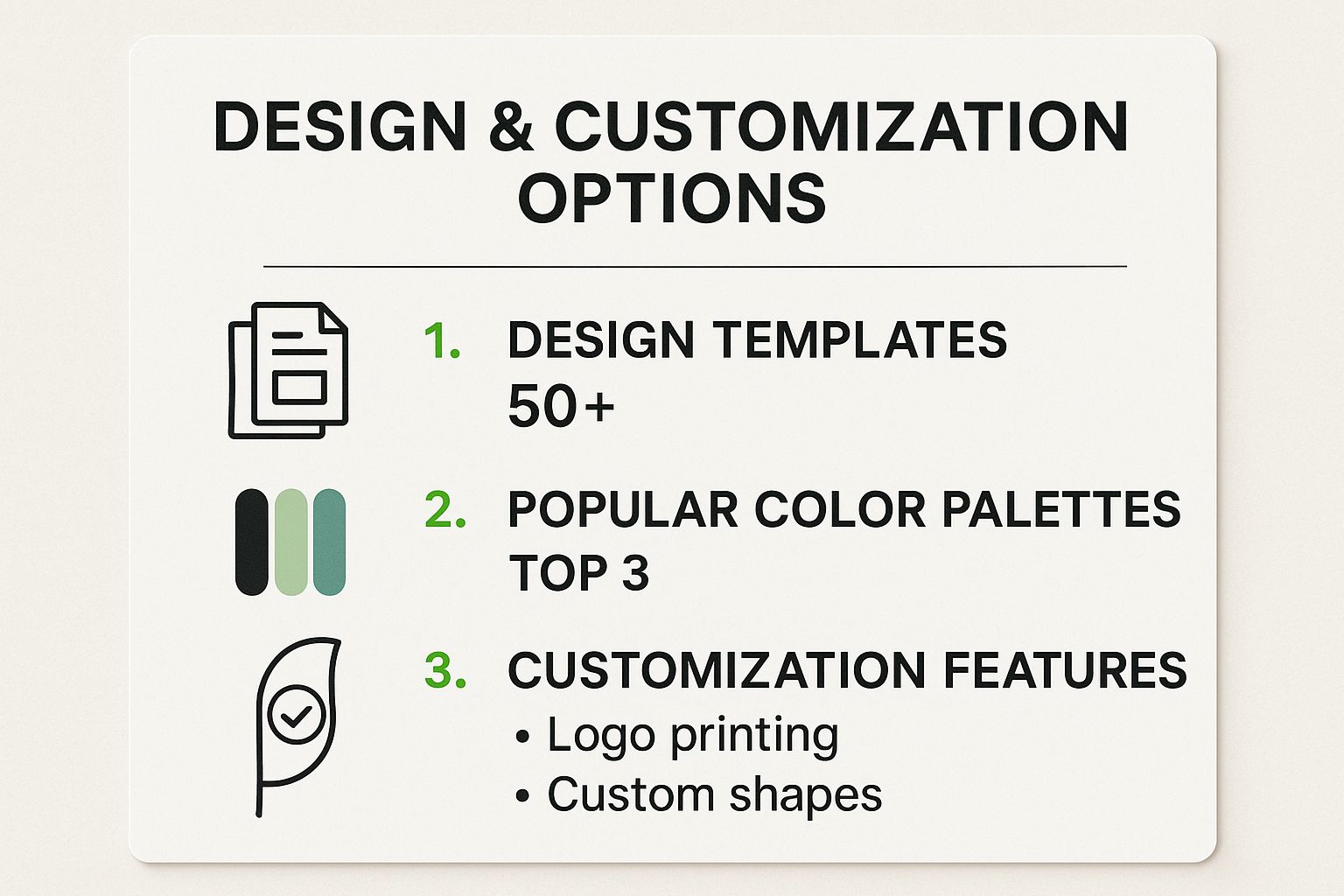Your cart is currently empty.

If you've ever been to an outdoor market, a sports event, or even just driven down a busy Kiwi street, you've definitely seen them: teardrop flags. These aren't your average flags; they're cleverly designed marketing tools built to grab attention in almost any outdoor setting.
Their unique, curved shape is what makes them so effective. It keeps the fabric pulled tight, so your message is always clear and readable, even on a still day. But when the wind picks up – as it so often does here in New Zealand – that’s when they really come alive.
What Are Teardrop Flags and Why They Work in NZ
Imagine trying to get noticed in a crowded space, like a weekend market in Christchurch or a bustling high street in Auckland. A static sign can easily get lost in the noise. A teardrop flag, on the other hand, is built to move. It’s less of a sign and more of an active beacon for your business.
The secret is in its aerodynamic design. Traditional rectangular flags often get wrapped around their poles or flap so wildly in a gusty nor'wester that you can't read them. Teardrop flags are different. Their curved top edge and tensioned pole mean they cut through the wind, staying stable and legible no matter which way the breeze is blowing.
Turning Wind into Visibility
It’s this constant, gentle fluttering that naturally catches the human eye. We’re wired to notice movement, and that’s the magic behind these flags. They don’t just sit there; they actively draw people in, turning a passing glance into genuine interest. It’s what might convince someone to cross the road to your café or help a visitor spot your booth at a packed trade show.
The benefits are pretty clear:
- Maximum Exposure: The shape ensures your branding is on display pretty much all the time.
- Increased Foot Traffic: That eye-catching movement naturally guides people your way.
- Professional Appearance: The clean, modern look gives a polished first impression and helps build trust in your brand.
Teardrop flags have a unique advantage: they turn a natural element—the wind—into a consistent marketing asset. They don't just put up with the weather; they use it to make sure your message gets seen.
This is why they've become such a go-to choice for businesses all over the country. In fact, it's estimated that teardrop flags now account for 40-50% of all promotional flags sold in major Kiwi cities like Auckland, Wellington, and Christchurch. Their popularity is a testament to how well they work for NZ businesses looking to make a real impact. If you want to dive deeper into flag usage, you can explore detailed insights from local industry suppliers.
Choosing Materials That Withstand NZ Conditions
Picking the right teardrop flag for New Zealand means getting one built to handle everything our unique climate can throw at it. From the relentless sun beating down in Hawke's Bay to the notorious southerly winds whipping through Wellington, your flag’s materials are the difference between a smart investment and a short-lived disappointment.
Think of it like choosing a jacket. A light windbreaker is fine for a calm day, but you’ll want something far more robust for a proper storm. The same logic applies here—your flag’s fabric and hardware need to work together to keep your brand looking sharp, rain or shine.

Fabric and Pole Durability
For teardrop flags here in NZ, the go-to material is a strong polyknit fabric. It hits that perfect sweet spot: lightweight enough to catch a gentle breeze but tough enough to resist tearing. If your flag will be in a spot with high winds or constant sun, make sure it’s printed with UV-resistant inks. This simple step stops your vibrant colours from fading into a pale memory.
Of course, the flag itself is only half the story. The pole is the backbone of the whole display.
- Fibreglass Poles: These are the industry standard for a very good reason. They're incredibly strong but also flexible, which means they can bend with the wind instead of snapping. This give is crucial for handling wind pressure and preventing damage.
- Aluminium Poles: You might see cheaper aluminium options, but they're much more rigid. A strong gust can leave them permanently bent or even broken, which not only ruins your display but can be a safety risk. Investing a little more in fibreglass pays off in the long run.
Selecting the Right Base for Stability
Your flag is only as secure as its base, and choosing the right one is non-negotiable for performance and safety, especially in public areas. It all comes down to where you plan to set it up.
The right base isn’t just an accessory; it's the foundation of your flag’s stability. Matching the base to the environment ensures your flag stays upright and effective, preventing it from becoming a hazard in windy conditions.
Here are the most common setups for different Kiwi locations:
- Ground Spikes: Absolutely perfect for soft ground like grass, soil, or sand. Think A&P shows, sports fields, or roadside displays where you can drive the spike securely into the earth.
- Cross Bases with Water Bags: This is your versatile, all-rounder for hard, flat surfaces. Concrete pavements, market squares, or indoor expo halls are where these shine. The cross base creates a stable footprint, and the fillable water bag adds the extra weight needed to anchor the flag against gusts.
- Heavy-Duty Square Bases: When you need maximum stability in a high-traffic or exposed spot, a solid metal plate is the ultimate anchor. They’re heavier to lug around, but they give you total peace of mind that your flag isn’t going anywhere.
By carefully matching the fabric, poles, and base to your needs, you can create a setup that NZ conditions simply can’t defeat, ensuring your brand stays visible and professional, day in and day out.
Designing Your Flag for Instant Brand Recognition
A well-made teardrop flag is a fantastic asset, but its real power comes from a smart, well-thought-out design. The unique shape is both a challenge and an opportunity. If you get it right, your flag won’t just flutter in the wind – it’ll actively grab attention and send a clear message from across the street.
The golden rule for Kiwi businesses designing teardrop flags is simple: less is more.
Think of your flag like a billboard on a busy motorway. You only have a few seconds to make an impression. If you cram it with phone numbers, websites, and complex sentences, it’ll become a blurry, unreadable mess, especially when it's flapping about.

Instead, stick to one clear goal. Is it to show off your logo? Announce a sale? Guide people to your entrance? Your entire design should support that single objective. If you're looking for clever ways to engage an audience, checking out some inspiring brand activation examples can really spark some ideas.
Making the Most of the Shape
The teardrop shape naturally draws the eye from top to bottom. That wide section at the top? That’s prime real estate. It's where your most important information absolutely must go. Stick your logo or key message there, as it’s the most stable part of the flag and stays visible even when it’s windy.
As the flag narrows towards the bottom, the space gets tighter and moves a lot more. This area is best for secondary things, like a simple graphic or a block of a contrasting colour that reinforces your brand.
Pro Tip: Always place your core message in the top third of the flag. This guarantees it gets seen, as it's the part least affected by movement and sits right at eye-level for people walking by.
Colours and Fonts That Work
Visibility is everything. Your design has to cut through the visual noise of a park, a busy city street, or a crowded trade show.
- High-Contrast Colours: You need colours that pop. Think bold pairings like black on yellow, white on a deep blue, or red on white. Steer clear of pastels or similar shades that will just blend into a muddy blob from a distance.
- Bold, Clean Fonts: Readability is key. Go for simple, sans-serif fonts like Arial, Helvetica, or Futura. They’re easy to read in a split second. Avoid anything too fancy, cursive, or thin – those fonts become impossible to decipher when the flag is fluttering. And make it big! The text needs to be legible from several metres away.
Single-Sided vs Double-Sided Printing
One last decision to make is the print style, and it’s a big one. Getting this right ensures your message is always seen correctly.
- Single-Sided Flags: Here, the design is printed on one side, and the ink soaks through to create a mirror image on the back. It’s a more budget-friendly choice, but remember, any text will be backwards on the reverse side.
- Double-Sided Flags: This is the premium option. We print on two separate pieces of fabric and sew them together with a special blockout liner in the middle. This means your message reads perfectly from both directions, which is essential for capturing foot traffic coming from anywhere.
Nailing these design basics will turn your teardrop flag from a simple marker into a powerful beacon for your brand, capturing attention and getting your message across loud and clear.
Picking the Perfect Size and Base for Your Spot
Choosing the right teardrop flag isn’t just about the design on the fabric. The size and how it's anchored are just as critical to making the impact you want. A flag that’s too small can get lost in the noise, while one that’s too big might look out of place or be a hassle to set up.
Think of it like choosing speakers for an event. You wouldn't bring a tiny Bluetooth speaker to a massive outdoor festival like Rhythm and Vines, but you also wouldn't haul a concert-sized rig into a small meeting room. The same logic applies to your teardrop flags NZ. You need to match the scale to the environment.
Before you buy, ask yourself a few simple questions. How far away do people need to see it? If you're indoors at a venue like the Auckland Showgrounds, what’s the ceiling height? If it’s going on the footpath outside your shop, how much space do you really have? The answers will quickly point you in the right direction.
Match the Flag Size to the Job
Teardrop flags typically come in three standard sizes, and each one is a tool for a different job. Figuring out which one you need is the first step.
-
Small Flags (Around 2.2m tall): These are your go-to for indoor events or tight outdoor spots. They're perfect for trade show booths, farmers' market stalls, or right beside the entrance to a cafe. They grab attention up close without getting in everyone's way.
-
Medium Flags (Around 3.5m tall): This is the trusty all-rounder. It's big enough to be noticed from the road, making it the top pick for real estate open homes, school sports days, or roadside businesses. It’s easily the most popular choice for general outdoor advertising.
-
Large Flags (4.5m or taller): When you absolutely have to be seen from a distance, go large. These are built for major outdoor events, car dealerships, and big festivals where you’re competing for eyeballs.
This image gives a great visual breakdown of how simple design choices can make your flag stand out, no matter which size you choose.

As you can see, a bold, simple colour scheme paired with a clean logo is often the most effective way to get your brand noticed.
Choosing the Right Base to Keep It Grounded
Finally, don't forget about stability. The base you pick is what keeps your flag upright and looking professional, and it has to be right for the surface you're on.
A flag with the wrong base is like a ship without an anchor—it won’t stay put. Matching your base to the ground is non-negotiable for performance and safety.
To make this easier, here's a quick guide to help you match your flag and base to common spots around New Zealand.
Teardrop Flag Size and Base Guide for NZ Venues
| Use Case | Recommended Size | Ideal Base Type | Key Consideration |
|---|---|---|---|
| Indoor Trade Show (e.g., The Cloud) | Small (2.2m) | Cross Base with Water Bag | Low ceiling heights and smooth, flat flooring. |
| Pavement Outside a Retail Shop | Small (2.2m) or Medium (3.5m) | Square Metal Base Plate | Foot traffic and council regulations for footpath space. |
| Sports Field or School Gala | Medium (3.5m) | Ground Spike | Soft ground allows for a very secure anchor. |
| Real Estate Open Home | Medium (3.5m) | Ground Spike or Cross Base | Versatility needed for grass berms or concrete driveways. |
| Outdoor Market (e.g., La Cigale) | Medium (3.5m) | Square Metal Base Plate | Often on hard surfaces; weight is needed for wind resistance. |
| Car Dealership Forecourt | Large (4.5m) | Heavy-Duty Square Base | Maximum visibility from the road and high wind exposure. |
| Beach Event or Festival | Large (4.5m) | Ground Spike (extra long) | Deep anchoring is needed in sand to combat coastal winds. |
For a sports field day, a ground spike driven into the grass is perfect. But for the footpath in town or inside a conference hall, you’ll want a cross base with a water bag for stability. If you're in a windy spot, a heavy-duty metal plate is your best bet.
By getting the size and the base right, you can be sure your flag will stand tall as a powerful and professional beacon for your brand.
Assembling and Looking After Your Teardrop Flag
Getting your teardrop flag set up correctly and giving it a bit of TLC is the secret to making sure it looks sharp and lasts for years. They're built tough to handle the outdoors, but a little care goes a long way in protecting your investment and keeping your brand looking its best.
Think of it like a good quality rain jacket; you wouldn't just throw it in a heap after getting caught in a downpour. Your flag needs the same basic attention to stay in top shape, always ready for your next event or promotion.
Simple Steps for a Pro Setup
Putting your flag together is quick and easy, but doing it right is what stops the fabric or pole from getting damaged. Most rips and tears happen when people rush this part, so taking an extra minute is always a good idea.
- Connect the Pole Sections: Lay out the pole sections and connect them, starting with the thickest piece at the bottom and working your way up to the thin, flexible tip.
- Slide the Flag On: Carefully thread the assembled pole through the flag’s sleeve. Go slowly, especially around the tight curve at the top, to make sure it doesn't snag or tear.
- Create the Tension: Once the flag is all the way on, find the little loop at the bottom and hook it onto the tensioner on the pole. This pulls the fabric taut and gives the flag its classic teardrop shape.
- Mount it on the Base: All done! Now just slot the bottom of the pole onto the spindle of your base, whether that’s a ground spike for the lawn or a cross base for the pavement.
Keeping Your Flag Looking Great
Just as important as putting it together is the ongoing care, especially with New Zealand's famously unpredictable weather. A few simple habits will make a huge difference to how long your flag lasts.
A well-cared-for flag says a lot about your brand's attention to detail. Proper maintenance ensures you're making a professional first impression, not a faded or frayed one.
To keep your teardrop flag in prime condition, just follow these practical tips.
- Bring it in During Rough Weather: Teardrop flags are designed for the outdoors, but they aren't invincible. If you see a MetService severe weather warning for high winds or storms, always bring your flags inside. This is the number one thing you can do to prevent serious damage.
- Clean it the Right Way: If it’s just a bit dusty or dirty, a spot clean with a damp cloth and some mild soapy water will do the trick. For a deeper clean, you can put it through a gentle, cold machine wash. Always hang it out to air dry – never put it in a machine dryer, as the heat will wreck the fabric and fade your print.
- Store it Smart: When you're not using it, take the flag off the pole, give it a neat fold, and store it somewhere dry and out of direct sunlight. Keeping the poles and base in their carry bag is a great way to prevent scratches and make sure all the bits and pieces are together for next time.
Aotearoa's Rich History of Flags and Identity
Before any business in NZ ever thought of using a teardrop flag for promotion, the flags flying over Aotearoa told a much deeper story. These weren't about catching a customer's eye; they were powerful statements about sovereignty, partnership, and a nation finding its feet.
Our story starts with Te Kara, the Flag of the United Tribes of New Zealand. Chosen by Māori rangatira (chiefs) way back in 1834, this flag was a game-changer. It gave Māori-owned ships the right to trade internationally without being seized, a massive step in asserting Māori mana and building relationships with the first European settlers.

From Te Kara to the Southern Cross
The path from that first flag to the one we know today mirrors New Zealand’s own journey. Once New Zealand became a British colony in 1840, the Union Jack was the official flag, but the desire for a distinct symbol was already growing strong. This led to the adoption of a British Blue Ensign, but with a local touch: the Southern Cross.
Flags are so much more than just pieces of fabric. They're visual stories, carrying the weight of history, identity, and the hopes of a nation.
That design saw a few tweaks over the years. By 1869, Governor Sir George Bowen settled on the version we recognise—the four red stars, outlined in white, anchoring us to our place in the Southern Hemisphere. This design became official with the New Zealand Ensign Act of 1902. If you're keen to dive deeper, you can read more about the flag's detailed evolution on Wikipedia.
This incredible history sets the stage for how we use flags today. When a modern Kiwi business puts up a teardrop flag, it's tapping into a very old tradition—using a banner to declare who you are and what you stand for. It’s a practice woven right into the fabric of Aotearoa.
Got Questions About Teardrop Flags? We’ve Got Answers.
Even after seeing how powerful teardrop flags can be for a Kiwi business, you probably still have a few practical questions. That’s completely normal. Sorting out the details is key to buying with confidence and getting a tool that really works for you.
Let's dive into the most common queries we get from businesses across New Zealand.
How Long Will My Teardrop Flag Last Outside?
Realistically, a well-made teardrop flag should give you a good one to two years of service outdoors. Of course, this all comes down to the local conditions. A flag tucked away in a sheltered courtyard will naturally outlast one battling the coastal winds in Wellington or the harsh sun in the Bay of Plenty.
The best thing you can do to get more life out of your flag is simple: bring it inside when the weather turns nasty. A single southerly buster or heavy storm can do more damage than months of regular use, so keeping it out of harm's way is a smart move.
What’s the Standard Turnaround Time?
For most teardrop flags NZ suppliers, you can expect to have your new flag in hand within four to five working days after you’ve given the final design the thumbs-up. This is a pretty reliable timeframe to work with when you're planning for an event or a promotion.
Stuck for time? Don't panic. Many printers offer a rush service for an extra fee. If you’ve got an event just around the corner, you can often get your flag sorted in just a couple of days. It never hurts to ask about express options if you're in a tight spot.
Just a heads-up: the production clock usually starts ticking after you’ve officially approved the artwork. Make sure you build in enough time for design and proofing to avoid any last-minute stress.
Can I Wash My Flag Fabric?
Yes, absolutely! Keeping your flag looking sharp is easy. For small smudges or a bit of dirt, just spot-clean it with a damp cloth and some mild soap. If it needs a proper clean, you can pop the fabric into the washing machine on a gentle, cold cycle.
Once it's washed, just hang it up to air dry. Whatever you do, never put it in a machine dryer. The intense heat can shrink the fabric, damage the fibres, and make your beautiful, vibrant print fade way too quickly. A little care goes a long way in keeping your brand looking its best.
Ready to make a powerful first impression that turns heads? The creative team at SONI DESIGN is here to bring your vision to life with high-quality teardrop flags that get you noticed. Check out our custom flag options.
Leave a Comment
Stay home & get your daily
needs from our shop
Start You'r Daily Shopping with Nest Mart
Best prices & offers
Orders $50 or more
Free delivery
24/7 amazing services
Great daily deal
When you sign up
Wide assortment
Mega Discounts
Easy returns
Within 30 days
